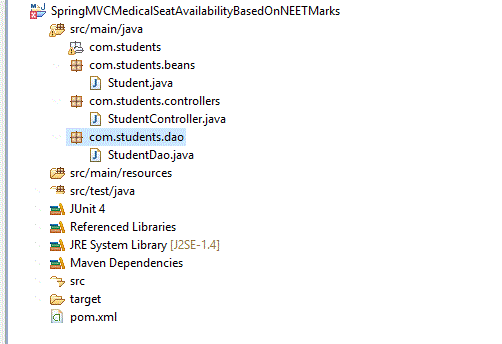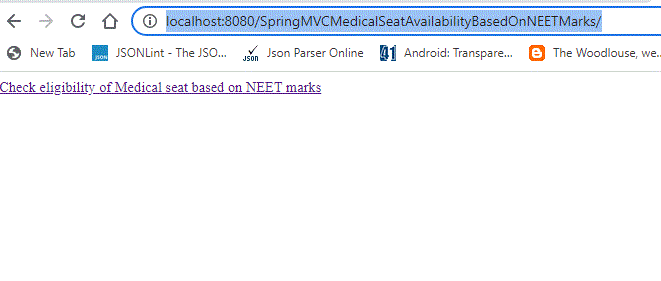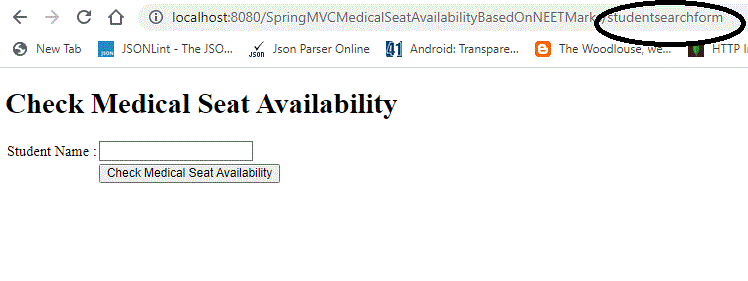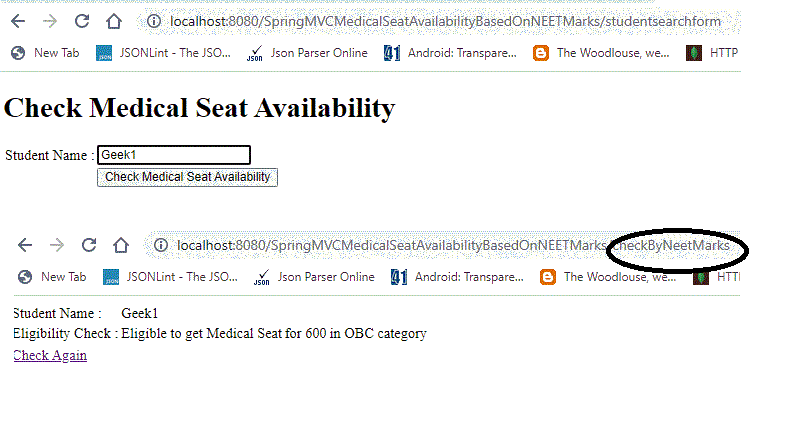Estaremos explicando los pasos involucrados en la integración de Spring MVC y MySQL . En MySQL, tendremos los datos necesarios que son la columna vertebral de la aplicación. Tomemos una aplicación de muestra que contiene los datos de algunos estudiantes y sus notas NEET. La aplicación Spring MVC interactuará con MySQL y recuperará los datos según sea necesario.
Pasos involucrados en la creación de la base de datos y la tabla
Paso 1: Crear la base de datos
1.1: Crear una base de datos de prueba.
-- test is the name of the database here
Paso 2: Hacer que la prueba de la base de datos sea activa
use test;
Paso 3: Crea la tabla
create table studentsdetails(id int auto_increment primary key, name varchar(25),caste varchar(25),neetmarks int,gender varchar(10));
Paso 4: inserte registros en él
--
insert into studentsdetails(name,caste,neetmarks,gender) values ('Geek1','OBC',600,'Female');
insert into studentsdetails(name,caste,neetmarks,gender) values ('Geek2','General',700,'Female');
insert into studentsdetails(name,caste,neetmarks,gender) values ('Geek3','General',600,'Male');
insert into studentsdetails(name,caste,neetmarks,gender) values ('Geek4','OBC',670,'Male');
insert into studentsdetails(name,caste,neetmarks,gender) values ('Geek5','SC',600,'Female');
insert into studentsdetails(name,caste,neetmarks,gender) values ('Geek6','SC',500,'Male');
Paso 5: seleccione los datos de él
select * from studentsdetails;

datos de detalles de los estudiantes
Ahora hagamos los pasos necesarios en la aplicación Spring MVC, la estructura del proyecto es la siguiente:

Archivo: pom.xml
XML
<project xmlns="http://maven.apache.org/POM/4.0.0" xmlns:xsi="http://www.w3.org/2001/XMLSchema-instance" xsi:schemaLocation="http://maven.apache.org/POM/4.0.0 http://maven.apache.org/maven-v4_0_0.xsd"> <modelVersion>4.0.0</modelVersion> <groupId>com.students</groupId> <artifactId>SpringMVCMedicalSeatAvailabilityBasedOnNEETMarks</artifactId> <packaging>war</packaging> <properties> <maven.compiler.source>1.8</maven.compiler.source> <maven.compiler.target>1.8</maven.compiler.target> </properties> <version>0.0.1-SNAPSHOT</version> <name>SpringMVCMedicalSeatAvailabilityBasedOnNEETMarks Maven Webapp</name> <url>http://maven.apache.org</url> <dependencies> <dependency> <groupId>junit</groupId> <artifactId>junit</artifactId> <version>4.12</version> <scope>test</scope> </dependency> <!-- https://mvnrepository.com/artifact/org.springframework/spring-webmvc --> <dependency> <groupId>org.mockito</groupId> <artifactId>mockito-all</artifactId> <version>1.9.5</version> <scope>test</scope> </dependency> <dependency> <groupId>org.springframework</groupId> <artifactId>spring-webmvc</artifactId> <version>5.1.1.RELEASE</version> </dependency> <dependency> <groupId>org.springframework</groupId> <artifactId>spring-context</artifactId> <version>5.1.1.RELEASE</version> </dependency> <dependency> <groupId>org.springframework</groupId> <artifactId>spring-test</artifactId> <version>5.1.1.RELEASE</version> <scope>test</scope> </dependency> <dependency> <groupId>org.springframework.boot</groupId> <artifactId>spring-boot-starter-test</artifactId> <version>2.4.1</version> <scope>test</scope> </dependency> <!-- https://mvnrepository.com/artifact/org.apache.tomcat/tomcat-jasper --> <dependency> <groupId>org.apache.tomcat</groupId> <artifactId>tomcat-jasper</artifactId> <version>9.0.12</version> </dependency> <!-- https://mvnrepository.com/artifact/javax.servlet/javax.servlet-api --> <dependency> <groupId>javax.servlet</groupId> <artifactId>servlet-api</artifactId> <version>3.0-alpha-1</version> </dependency> <!-- https://mvnrepository.com/artifact/javax.servlet/jstl --> <dependency> <groupId>javax.servlet</groupId> <artifactId>jstl</artifactId> <version>1.2</version> </dependency> <!-- https://mvnrepository.com/artifact/mysql/mysql-connector-java --> <!-- This is much required to connect to MySQL --> <dependency> <groupId>mysql</groupId> <artifactId>mysql-connector-java</artifactId> <version>8.0.11</version> </dependency> <!-- https://mvnrepository.com/artifact/org.springframework/spring-jdbc --> <dependency> <groupId>org.springframework</groupId> <artifactId>spring-jdbc</artifactId> <version>5.1.1.RELEASE</version> </dependency> </dependencies> <build> <finalName>SpringMVCMedicalSeatAvailabilityBasedOnNEETMarks</finalName> <sourceDirectory>src/main/java</sourceDirectory> <plugins> <plugin> <groupId>org.apache.maven.plugins</groupId> <artifactId>maven-surefire-plugin</artifactId> <version>3.0.0-M3</version> <configuration> <testFailureIgnore>true</testFailureIgnore> <shutdown>kill</shutdown> <!-- Use it if required--> </configuration> </plugin> <plugin> <groupId>org.apache.maven.plugins</groupId> <artifactId>maven-war-plugin</artifactId> <version>3.3.2</version> </plugin> <plugin> <groupId>org.codehaus.mojo</groupId> <artifactId>tomcat-maven-plugin</artifactId> <version>1.0-beta-1</version> </plugin> </plugins> </build> </project>
Archivo: spring-servlet.xml
Este es el archivo más necesario para comunicarse con MySQL
XML
<?xml version="1.0" encoding="UTF-8"?> <beans xmlns="http://www.springframework.org/schema/beans" xmlns:xsi="http://www.w3.org/2001/XMLSchema-instance" xmlns:context="http://www.springframework.org/schema/context" xmlns:mvc="http://www.springframework.org/schema/mvc" xsi:schemaLocation=" http://www.springframework.org/schema/beans http://www.springframework.org/schema/beans/spring-beans.xsd http://www.springframework.org/schema/context http://www.springframework.org/schema/context/spring-context.xsd http://www.springframework.org/schema/mvc http://www.springframework.org/schema/mvc/spring-mvc.xsd"> <context:component-scan base-package="com.students.controllers"></context:component-scan> <bean class="org.springframework.web.servlet.view.InternalResourceViewResolver"> <property name="prefix" value="/WEB-INF/jsp/"></property> <property name="suffix" value=".jsp"></property> </bean> <!-- According to the username and password that we use, the changes need to be done below --> <!-- Generally username will be root and password will be empty or will come with a password Hence accordingly change the data here --> <bean id="ds" class="org.springframework.jdbc.datasource.DriverManagerDataSource"> <property name="driverClassName" value="com.mysql.jdbc.Driver"></property> <!-- <property name="url" value="jdbc:mysql://localhost:3306/test"></property> --> <!-- Here test is the name of the database --> <property name="url" value="jdbc:mysql://localhost:3306/test?user=root&password=password&serverTimezone=UTC"></property> <!-- <property name="username" value="root"></property> <property name="password" value="password"></property> --> </bean> <bean id="jt" class="org.springframework.jdbc.core.JdbcTemplate"> <property name="dataSource" ref="ds"></property> </bean> <bean id="dao" class="com.students.dao.StudentDao"> <property name="template" ref="jt"></property> </bean> </beans>
Pasemos ahora a la ‘ clase de frijoles ‘. Los campos de esta clase de bean deben ser equivalentes a la estructura de la tabla MySQL . Solo así será más fácil y efectivo comunicarse.
Archivo: Student.java
Java
// Java Program to Illustrate Student Class
// Class
public class Student {
// Class data members
// Map to studentsdetails.id
private int id;
// Map to studentsdetails.name
private String name;
// Map to studentsdetails.caste
private String caste;
// Map to studentsdetails.neetMarks
private int neetMarks;
// Map to studentsdetails.gender
private String gender;
// Getter and setter methods
// Getter
public int getNeetMarks() { return neetMarks; }
// Setter
public void setNeetMarks(int neetMarks)
{
this.neetMarks = neetMarks;
}
// Getter
public String getGender() { return gender; }
// Setter
public void setGender(String gender)
{
this.gender = gender;
}
// Getter
public int getId() { return id; }
// Setter
public void setId(int id) { this.id = id; }
// Getter
public String getName() { return name; }
// Setter
public void setName(String name) { this.name = name; }
// Getter
public String getCaste() { return caste; }
// Setter
public void setCaste(String caste)
{
this.caste = caste;
}
}
Ahora para hacer las operaciones de la base de datos, necesitamos el archivo java DAO
Archivo: StudentDao.java
Java
// Java Program to Illustrate StudentDao Class
// Importing required classes
import com.students.beans.Student;
import java.sql.SQLException;
import org.springframework.jdbc.core.BeanPropertyRowMapper;
import org.springframework.jdbc.core.JdbcTemplate;
// Class
public class StudentDao {
JdbcTemplate template;
public void setTemplate(JdbcTemplate template)
{
this.template = template;
}
// We can search the data from MySQL by means of
// studentname
public Student getStudentsByName(String studentName)
throws SQLException
{
String sql
= "select * from studentsdetails where name=?";
return template.queryForObject(
sql, new Object[] { studentName },
new BeanPropertyRowMapper<Student>(
Student.class));
}
// We can search the data from MySQL by means of caste
public Student getStudentsByCaste(String caste)
throws SQLException
{
String sql
= "select * from studentsdetails where caste=?";
return template.queryForObject(
sql, new Object[] { caste },
new BeanPropertyRowMapper<Student>(
Student.class));
}
// We can search the data from MySQL by means of id
public Student getStudentsById(int id)
throws SQLException
{
String sql
= "select * from studentsdetails where id =?";
return template.queryForObject(
sql, new Object[] { id },
new BeanPropertyRowMapper<Student>(
Student.class));
}
// We can search the data from MySQL by means of
// neetmarks
public Student getStudentsByNeetMarks(int neetMarks)
throws SQLException
{
String sql
= "select * from studentsdetails where neetMarks=?";
return template.queryForObject(
sql, new Object[] { neetMarks },
new BeanPropertyRowMapper<Student>(
Student.class));
}
// As much of business logic can be written here
}
Veamos ahora la clase de controlador.
StudentController.java
Java
// Java Program to Illustrate StudentController Class
// Importing required classes
import com.students.beans.Student;
import com.students.dao.StudentDao;
import java.sql.SQLException;
import org.springframework.beans.factory.annotation.Autowired;
import org.springframework.stereotype.Controller;
import org.springframework.ui.Model;
import org.springframework.web.bind.annotation.ModelAttribute;
import org.springframework.web.bind.annotation.RequestMapping;
import org.springframework.web.bind.annotation.RequestMethod;
import org.springframework.web.bind.annotation.SessionAttributes;
import org.springframework.web.servlet.ModelAndView;
// Class
@Controller
@SessionAttributes("student")
public class StudentController {
// @Autowired
// It will inject dao from xml file
StudentDao dao;
@Autowired public StudentController(StudentDao dao)
{
// this keyword refers to current instance itself
this.dao = dao;
}
@ModelAttribute("student") public Student getStudent()
{
return new Student();
}
// For searchform
@RequestMapping("/studentsearchform")
public String searchform(Model m)
{
m.addAttribute("command", new Student());
return "studentsearchform";
}
// It provides check students and determines
// for medical seat availability based on NEET marks
// in model object
// It is up to one to change the logic here
// for the availability of medical seat
// Just to show as an example, below calculations
// aretaken Exception need to be handled carefully as
// interacting with database
@RequestMapping(value = "/checkByNeetMarks",
method = RequestMethod.POST)
public ModelAndView
checkByNeetMarks(@ModelAttribute("student")
Student student)
{
ModelAndView mav = null;
Student student1;
// Try block to check for exceptions
try {
student1
= dao.getStudentsByName(student.getName());
mav = new ModelAndView("welcome");
if (null != student1) {
System.out.println(
student1.getId() + "..."
+ student1.getName() + ".."
+ student1.getCaste() + "..neet marks.."
+ student1.getNeetMarks());
boolean isAvailable = false;
if (student1.getCaste().equalsIgnoreCase(
"General")
&& student1.getNeetMarks() >= 600) {
isAvailable = true;
}
if (student1.getCaste().equalsIgnoreCase(
"OBC")
&& student1.getNeetMarks() >= 500) {
isAvailable = true;
}
if (student1.getCaste().equalsIgnoreCase(
"SC")
&& student1.getNeetMarks() >= 400) {
isAvailable = true;
}
mav.addObject("firstname",
student1.getName());
if (isAvailable) {
mav.addObject(
"availability",
"Eligible to get Medical Seat");
}
else {
mav.addObject(
"availability",
"Not eligible to get Medical Seat");
}
mav.addObject("caste", student1.getCaste());
mav.addObject("neetmarks",
student1.getNeetMarks());
}
else {
mav.addObject("firstname",
student.getName());
mav.addObject(
"availability",
"Not present in the database");
// mav.addObject("location",
// student.getLocation());
}
}
// Catch block to handle SQL Exceptions
catch (SQLException e) {
// Displaying exception along with line number
// using printStackTrace() method
e.printStackTrace();
}
return mav;
}
}
El conjunto anterior se puede preparar como un archivo war y se puede implementar en la carpeta tomcat webapps.
Al comienzo de Tomcat , la aplicación anterior se puede invocar usando
http://localhost:8080/SpringMVCMedicalSeatAvailabilityBasedOnNEETMarks/
Como esto se toma como un proyecto de muestra, no se hace mucho embellecimiento

Podemos hacer clic en este enlace y avanzar
Al hacer clic en el enlace, obtendremos lo siguiente

Compruebe el cambio de URL. Todo debe estar alineado con el controlador.
Caso de uso :

Según la lógica escrita, estamos obteniendo resultados, aquí
- “Geek1 ” es el nombre que se le da a la búsqueda. Se comparará con la tabla «studentsdetails»
- El círculo indica el nombre de la asignación de solicitud.
Es una aplicación de muestra y se dan los pasos necesarios en esta que interactúa con la base de datos MySQL. Usando Spring MVC y MySQL, podemos llevar a cabo fácilmente la lógica comercial.
Publicación traducida automáticamente
Artículo escrito por priyarajtt y traducido por Barcelona Geeks. The original can be accessed here. Licence: CCBY-SA